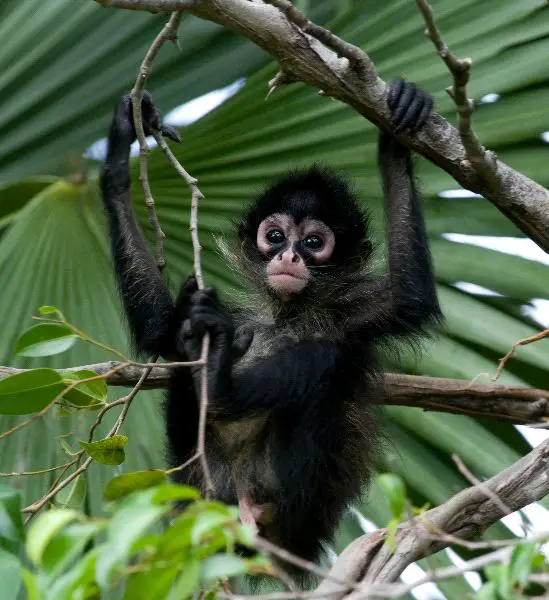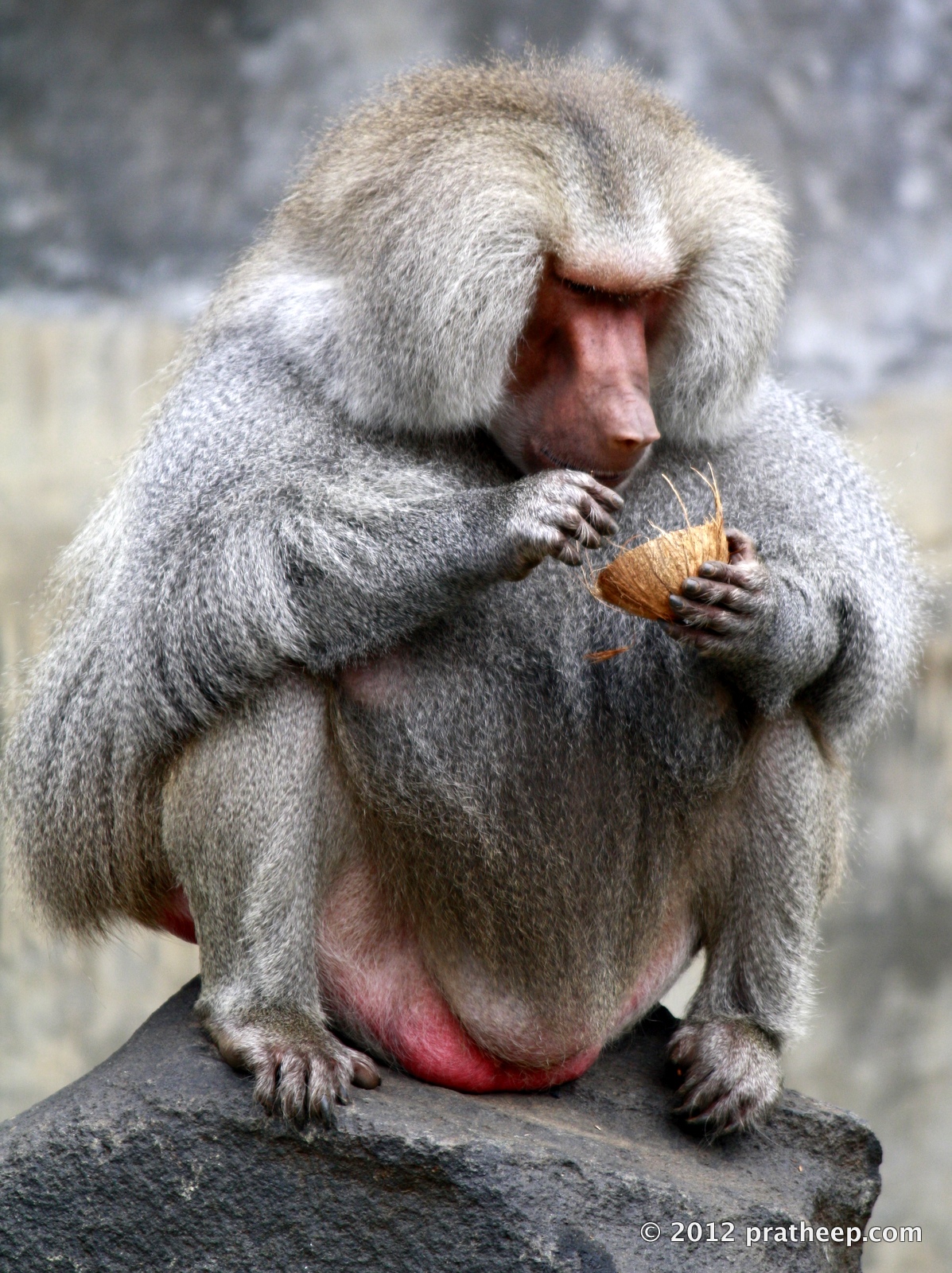 Spider Monkey (New World Monkey/Platyrrhini)
a. Spider Money's live in the Central and South Americas. They live in tropical, evergreen forests. Spider monkeys live in upper canopy tree tops. They almost never come down to the floor level.
b. Spider Monkeys do not possess thumbs. Their hands are long, narrow and almost hook-like. Their fingers are elongated and recurved with reduced thumbs. Their hands allow them to swing from tree tops and they have long limbs to grasp branches.
c. Spider Monkeys reduced thumbs are an adaption to their arboreal environment. They didn't use their thumbs in the high tree tops so they evolved into smaller fingers in order to a.
d.
Spider Monkey (New World Monkey/Platyrrhini)
a. Spider Money's live in the Central and South Americas. They live in tropical, evergreen forests. Spider monkeys live in upper canopy tree tops. They almost never come down to the floor level.
b. Spider Monkeys do not possess thumbs. Their hands are long, narrow and almost hook-like. Their fingers are elongated and recurved with reduced thumbs. Their hands allow them to swing from tree tops and they have long limbs to grasp branches.
c. Spider Monkeys reduced thumbs are an adaption to their arboreal environment. They didn't use their thumbs in the high tree tops so they evolved into smaller fingers in order to a.
d.  Baboon (Old World Monkey/Cercopithecidae)
a. Baboons live in either tall trees or on cliff faces. Their habitat varies based upon water source and safe areas to sleep. They live primarily in Africa and also Arabia. Baboons live in the woodlands and savannas.
b. Baboon's hands are human like and are capable of grasping and manipulating objects. They use their thumbs and forefingers to manipulate their foods such as nuts, fruit, and flowers. They also eat meats at times and shellfish.
c. Baboon's hands have been influenced by their habitat by their knuckles and hands are used to prop themselves up when walking on the ground. This is also an adaption because baboons need their opposable fingers to eat and forage.
d.
Baboon (Old World Monkey/Cercopithecidae)
a. Baboons live in either tall trees or on cliff faces. Their habitat varies based upon water source and safe areas to sleep. They live primarily in Africa and also Arabia. Baboons live in the woodlands and savannas.
b. Baboon's hands are human like and are capable of grasping and manipulating objects. They use their thumbs and forefingers to manipulate their foods such as nuts, fruit, and flowers. They also eat meats at times and shellfish.
c. Baboon's hands have been influenced by their habitat by their knuckles and hands are used to prop themselves up when walking on the ground. This is also an adaption because baboons need their opposable fingers to eat and forage.
d.
Gibbon (Lesser ape/Hylobatidae) a. Gibbons live in rain forests of Southeast Asia and Indonesia. They are also found in the forests of the highlands of China. They are rarely found on the ground floor and when they are they are erect and upright. In trees they swing long ranges. b. Gibbons have hands much similar to humans with long fingers and a smaller opposable thumb. Their feet are the same with four toes and an opposable big toe. When swinging through the trees they use their four fingers to grab branches but not their thumbs. c. Gibbons hands and feet have been influenced by the fact that they are always in the trees and that they primarily are foragers. They have adapted for the same reason that Gibbons need to use their hands and feet for maintaining their life style in the tree tops. d.
 Chimpanzee (Great ape/Hominidae)
a. Chimpanzees live in rain forests and wet savannas, also woodlands and bamboo forests. They fluctuate between being on the ground and in the trees. They do most of their eating and sleeping in the safety of the canopy tops of forests. They are found in Africa.
b. Chimpanzees hands and feet are much like that of humans. They have five fingers with an opposable thumb and five toes with and opposable big toe. They used both their hands and feet for grabbing things. Chimpanzees used their thumbs and middle fingers to manipulate objects rather than forefinger.
c. Chimpanzees environment influenced their hands and feet to be needed to keep balance in the tree tops since they do not obtain tails as leverage. This could be why they adapted to have opposable thumbs. I think that their environment of having to stay high up in the trees for safety enabled this adaption to happen.
d.
Chimpanzee (Great ape/Hominidae)
a. Chimpanzees live in rain forests and wet savannas, also woodlands and bamboo forests. They fluctuate between being on the ground and in the trees. They do most of their eating and sleeping in the safety of the canopy tops of forests. They are found in Africa.
b. Chimpanzees hands and feet are much like that of humans. They have five fingers with an opposable thumb and five toes with and opposable big toe. They used both their hands and feet for grabbing things. Chimpanzees used their thumbs and middle fingers to manipulate objects rather than forefinger.
c. Chimpanzees environment influenced their hands and feet to be needed to keep balance in the tree tops since they do not obtain tails as leverage. This could be why they adapted to have opposable thumbs. I think that their environment of having to stay high up in the trees for safety enabled this adaption to happen.
d.  Summarize your findings, evaluating the level of influence the environment has on the expression of physical
and behavioral traits. (15 pts)
In doing my research of the five primates I found that not all of them have the opposable thumbs like I have initially thought. It proved to me that habitat has a big impact on how primates evolve and change in order to maintain their life styles in their environment. Although they do all reside in the trees and move similarly through the trees, they do not use their hands and feet in the same ways. While some use them to eat, others need them to hold onto branches, and they need their hands and feet to do both at times. The environment that primates are located in is very influential to the way they use their hands and feet because if they did not live in forests or in trees they probably would loose the opposable thumb usage and just have small thumbs such as the lemur.
Summarize your findings, evaluating the level of influence the environment has on the expression of physical
and behavioral traits. (15 pts)
In doing my research of the five primates I found that not all of them have the opposable thumbs like I have initially thought. It proved to me that habitat has a big impact on how primates evolve and change in order to maintain their life styles in their environment. Although they do all reside in the trees and move similarly through the trees, they do not use their hands and feet in the same ways. While some use them to eat, others need them to hold onto branches, and they need their hands and feet to do both at times. The environment that primates are located in is very influential to the way they use their hands and feet because if they did not live in forests or in trees they probably would loose the opposable thumb usage and just have small thumbs such as the lemur.
Great images!
ReplyDeleteI think you have a misconception as to what a locomotor trait or pattern actually is. You do well to describe the specific physical traits that each primates use to move through their environment, but you never identify the locomotive pattern itself. For instance, the locomotive pattern for lemurs is described and names a "clinging and leaping", which means they maintain an upright posture, holding onto branches and trunks, and leaping/jumping to another branch. So how would you classify the patterns of the other primates?
The focus on opposable thumbs was an interesting take, but how does the environment (which includes food availability and predation, among other things) influence a primate's locomotive pattern? Why are some primates arboreal and others are terrestrial? This was the focus of this assignment.
Very good post!
ReplyDeleteI was surprised to learn that Lemurs have a "toilet claw" which is used for grooming and scratching. It made me think of how mutation played such a big role on such a small aspect, a nail. Also, it was interesting how many of the primates you explained evolved they hands and feet in order to leave in trees. (for example the Gibbon).
Overall very good research on the locomotor patterns present in the five primates.